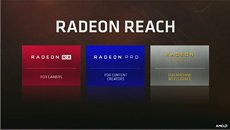Raevenlord
News Editor
- Joined
- Aug 12, 2016
- Messages
- 3,755 (1.21/day)
- Location
- Portugal
| System Name | The Ryzening |
|---|---|
| Processor | AMD Ryzen 9 5900X |
| Motherboard | MSI X570 MAG TOMAHAWK |
| Cooling | Lian Li Galahad 360mm AIO |
| Memory | 32 GB G.Skill Trident Z F4-3733 (4x 8 GB) |
| Video Card(s) | Gigabyte RTX 3070 Ti |
| Storage | Boot: Transcend MTE220S 2TB, Kintson A2000 1TB, Seagate Firewolf Pro 14 TB |
| Display(s) | Acer Nitro VG270UP (1440p 144 Hz IPS) |
| Case | Lian Li O11DX Dynamic White |
| Audio Device(s) | iFi Audio Zen DAC |
| Power Supply | Seasonic Focus+ 750 W |
| Mouse | Cooler Master Masterkeys Lite L |
| Keyboard | Cooler Master Masterkeys Lite L |
| Software | Windows 10 x64 |
Where is Vega? When is it launching? On AMD's Financial Analyst Day 2017, Raja Koduri spoke about the speculation in the past few weeks, and brought us an answer: Radeon Vega Frontier Edition is the first iteration of Vega, aimed at data scientists, immersion engineers and product designers. It will be released in the second half of June for AMD's "pioneers". The wording, that Vega Frontier Edition will be released in the second half of June, makes it so that AMD still technically releases Vega in the 2H 2017... It's just not the consumer, gaming Vega version of the chip. This could unfortunately signify an after-June release time-frame for consumer GPUs based on the Vega micro-architecture.
This news comes as a disappointment to all gamers who have been hoping for Vega for gaming, because it reminds of what happened with dual Fiji. A promising design which ended up unsuitable for gaming and was thus marketed for content creators as Radeon Pro Duo, with little success. But there is still hope: it just looks like we really will have to wait for Computex 2017 to see some measure of details on Vega's gaming prowess.




Vega Frontier Edition is the Vega GPU we've been seeing in leaks in the last few weeks, packing 16 GB of HBM2 memory, which, as we posited, didn't really make much sense on typical gaming workloads. But we have to say that if AMD's Vega truly does deliver only a 1.5x improvement in FP32 performance (the one that's most critical for gaming at the moment), this probably paints AMD's Vega as fighting an uphill battle against NVIDIA's Pascal architecture (probably ending up somewhere between GTX 1070 and GTX 1080). If these are correct, this could mean a dual GPU Vega is indeed in the works, so as to allow AMD to reclaim the performance crown from NVIDIA, albeit with a dual-GPU configuration against NVIDIA's current single-chip performance king, Titan Xp. Also worth nothing is that the AMD Radeon Vega Frontier Edition uses two PCI-Express 8-pin power connectors, which suggests a power draw north of 300 Watts.

For now, it seems AMD actually did its best to go all out on the machine learning craze, looking for the higher profits that are available in the professional market segment than on the consumer side of graphics. Let's just hope they didn't do so at the expense of gaming performance leaps.
After an initial throwback to AMD's times since he became lead of Radeon Technologies Group, where Raja mentioned the growing amount of graphics engineers in AMD, including their commitment to the basics of graphics computing: power, performance, and software. Better basics in hardware, software, and marketing are things that Raja says are responsible for AMD's current market outlook, both from a gamer and content creator perspective, which led to an increase in AMD's graphics marketshare.




RTG's chapter two of Radeon Rising, going beyond the basics, will allow the company to go after premium market dollars, with an architecture that excels on both gaming and CAD applications. Raja Koduri said he agreed with NVIDIA CEO Jensen Huang in that at some point in the future, every single human being will be a gamer.




The final configuration of Vega was finalized some two years ago, and AMD's vision for it was to have a GPU that could plow through 4K resolutions at over 60 frames per second. And Vega has achieved it. Sniper Elite 4 at over 60 FPS on 4K. Afterwards, Raja talked about AMD's High Bandwidth Cache Controller, running Rise of the Tomb Raider, giving the system only 2 GB of system memory, with the HBCC-enabled system delivering more than 3x the minimum frame-rates than the non-HBCC enabled system, something we've seen in the past, though on Deus Ex: mankind Divided. So now we know that wasn't just a single-shot trick.



Raja Koduri then showed AMD's SSG implementation and how it works on a fully ray-traced environment, with the SSG system delivering much smoother transitions in the system. AMD worked with Adobe on integrating SSG capability into Adobe Premiere Pro.



Raja then jumped towards machine intelligence, which Raja believes will be dominated not by the GPU (NVIDIA's green) or CPU (Intel blue) paths, but in true heterogeneous computing.



Raja took to stage results on DeepBench, a machine learning benchmark where NVIDIA dominates at the moment, joking about AMD's absence from the benchmark - since they really didn't have a presence in this area. In a benchmark, AMD pitted Vega against NVIDIA's P100 architecture (interestingly, not against NVIDIA's recently announced V100 architecture, which brings many specific improvements to this kind of workloads), delivering an almost 30% performance lead.



View at TechPowerUp Main Site
This news comes as a disappointment to all gamers who have been hoping for Vega for gaming, because it reminds of what happened with dual Fiji. A promising design which ended up unsuitable for gaming and was thus marketed for content creators as Radeon Pro Duo, with little success. But there is still hope: it just looks like we really will have to wait for Computex 2017 to see some measure of details on Vega's gaming prowess.




Vega Frontier Edition is the Vega GPU we've been seeing in leaks in the last few weeks, packing 16 GB of HBM2 memory, which, as we posited, didn't really make much sense on typical gaming workloads. But we have to say that if AMD's Vega truly does deliver only a 1.5x improvement in FP32 performance (the one that's most critical for gaming at the moment), this probably paints AMD's Vega as fighting an uphill battle against NVIDIA's Pascal architecture (probably ending up somewhere between GTX 1070 and GTX 1080). If these are correct, this could mean a dual GPU Vega is indeed in the works, so as to allow AMD to reclaim the performance crown from NVIDIA, albeit with a dual-GPU configuration against NVIDIA's current single-chip performance king, Titan Xp. Also worth nothing is that the AMD Radeon Vega Frontier Edition uses two PCI-Express 8-pin power connectors, which suggests a power draw north of 300 Watts.

For now, it seems AMD actually did its best to go all out on the machine learning craze, looking for the higher profits that are available in the professional market segment than on the consumer side of graphics. Let's just hope they didn't do so at the expense of gaming performance leaps.
After an initial throwback to AMD's times since he became lead of Radeon Technologies Group, where Raja mentioned the growing amount of graphics engineers in AMD, including their commitment to the basics of graphics computing: power, performance, and software. Better basics in hardware, software, and marketing are things that Raja says are responsible for AMD's current market outlook, both from a gamer and content creator perspective, which led to an increase in AMD's graphics marketshare.




RTG's chapter two of Radeon Rising, going beyond the basics, will allow the company to go after premium market dollars, with an architecture that excels on both gaming and CAD applications. Raja Koduri said he agreed with NVIDIA CEO Jensen Huang in that at some point in the future, every single human being will be a gamer.




The final configuration of Vega was finalized some two years ago, and AMD's vision for it was to have a GPU that could plow through 4K resolutions at over 60 frames per second. And Vega has achieved it. Sniper Elite 4 at over 60 FPS on 4K. Afterwards, Raja talked about AMD's High Bandwidth Cache Controller, running Rise of the Tomb Raider, giving the system only 2 GB of system memory, with the HBCC-enabled system delivering more than 3x the minimum frame-rates than the non-HBCC enabled system, something we've seen in the past, though on Deus Ex: mankind Divided. So now we know that wasn't just a single-shot trick.



Raja Koduri then showed AMD's SSG implementation and how it works on a fully ray-traced environment, with the SSG system delivering much smoother transitions in the system. AMD worked with Adobe on integrating SSG capability into Adobe Premiere Pro.



Raja then jumped towards machine intelligence, which Raja believes will be dominated not by the GPU (NVIDIA's green) or CPU (Intel blue) paths, but in true heterogeneous computing.



Raja took to stage results on DeepBench, a machine learning benchmark where NVIDIA dominates at the moment, joking about AMD's absence from the benchmark - since they really didn't have a presence in this area. In a benchmark, AMD pitted Vega against NVIDIA's P100 architecture (interestingly, not against NVIDIA's recently announced V100 architecture, which brings many specific improvements to this kind of workloads), delivering an almost 30% performance lead.



View at TechPowerUp Main Site
Last edited:





